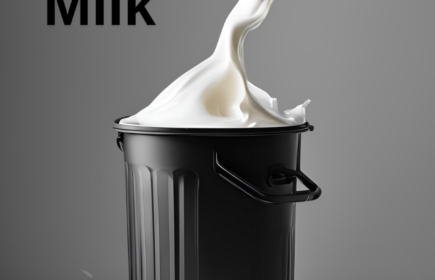Canada's dairy industry is dumping milk
In early October, a paper was published that shed light on waste in Canada’s milk industry, which for us non-dairy producers, seemed like an ungodly percentage of fluid milk to go to waste, as the paper estimated that about 7% of the milk that is produced is dumped on the ground. You can access this paper by Thomas Elliot, Benjamin Goldstein, and Sylvain Charlebois, and read why this number isn’t zero and the reasons why milk gets dumped all around the world. This blog is not to point fingers at the dairy industry, but to ask ourselves as consumers, is this 7% number truly concerning to us, and if so, what are we willing to do about it? Because let’s be honest, it is easier to point fingers at others, than to take responsibility ourselves. So, if this is a concern, let’s find some solutions to dumping milk.
First, let’s start by saying the dairy industry is a complex system of supply, demand, processing, and perishability. Dairy producers have contracts to deliver x amount of fluid milk to processors, and it is better to be paid your full contract by overproducing rather than lose money when you underproduce. In Canada, these dairy contracts fall under supply management, meaning producers have a set quota to sell under their contract each month. In this supply management system (SMS), dairy producers do not need to be competitive with one another in Canada, so it does offer an opportunity for the industry to support one another, but it also means you as a producer do not profit from your excess. You only profit from meeting your quota contracts each month, but you do not lose your quota allotment if you are short supply each month. How it works is if a producer exceeds their quota for that month, the milk goes to the processor at no sale to the producer if the SMS has a shortage of supply from other producers. The SMS is a way to help dairy producers reduce risk and be ‘fluid’ in their supply, but it doesn’t necessarily make it a competitive system. This post isn’t going to dig further into SMS, no matter how you may feel about it, it is the current system we have in place, and it continues to produce a great and safe product across our nation.
Why dairies dump
To ensure that producers are always producing enough, for the sake of their contracts, they would prefer to have excess milk. However, cows do not always produce the same amount of milk each day of their up to 305-day lactation. For instance, in higher temperatures, cows eat less and therefore produce less milk; feed plays a large impact on the production of milk and the composition of the milk, as does the age of the cow and whether she is newly milking or near the end of her milking days. Since milk production is not 100% predictable, producers err on the safe side and try to ensure overproduction to protect their contracts, which may result in some dumped milk. This is because when you overproduce, you ensure the revenue of your contract, but when you short your full quota, it means a revenue loss.
Excess milk is an issue in the world of perishable food products. While we would love to say no milk gets spilt, if there isn’t the capacity to store it or the throughput to process it all, excess milk will get dumped. Fluid milk coming from a dairy needs to be processed within a small time frame, and cannot be held for later down the road (interesting story about USA-stored milk and their “government cheese”). Milk is a market ‘today’ food, and not a let’s see what the market has in store next week.
Everyone Dumps
As explained by Elliot et al, in their paper, they mention that every nation has milk dumping. In the USA, their rate is between 0.2% – 0.5%; Sweden’s is also relatively low at 0.3%, while Scotland and France have slightly higher numbers like 1.8% and 3.5%. However, none are as high as the estimated 7% of Canada. Why is Canada’s rate so much higher? Well, it could be several factors. As an SMS, we don’t have the same access to export and import dairy products, which means that we can’t sell our excess milk to our neighbours to the south. Since we are a SMS, we have a very contained processing system of fluid milk, and our processing often is set to match the demand and markets of our Canadian consumption. So, while we are producing more, it doesn’t mean we have a growing demand for more milk-based goods domestically.
In places like the USA, where dairy operates in perfect competition, it is a hard industry to be in, especially as prices can be volatile, and production can vary. That’s where the USA may have been more strategic in ensuring that their production is close to the needed processing demands, to reduce the chances of losses. As well, producers are free to sell excess to others needing help to fill their contracts. But maybe more importantly, the USA has built-in options for a producer to reduce their risk (dairy margin coverage), and opportunities that use excess milk through the Farm Bill and other programs. There is the Special Milk Program, in which milk is freely given to young children at school, childcare, camps, etc. They also have the Milk Donation Reimbursement Program, established in the Farm Bill, for producers to donate fluid milk to avoid seeing it being dumped, and the Dairy Donation Program which came out of COVID, again to reduce the waste. According to the Farm Bill, between October 2019, and June 2022, over 15 million lbs of milk products were donated to these two programs.
Food Waste cannot = Zero
We are living in a time when we have good reason to reduce our food waste, but we also know that food waste cannot be equal to zero. That is a form of utopia we just cannot achieve. The flow of food in a supply chain goes from grower/producer, processor, retailer to consumer. Along this chain, there is food loss, in which some of the loss can be diverted for other food use, non-food use, and others it does to the ‘landfill’. In terms of fluid milk, if the grower has excess milk, they have the choice to try to deliver the excess milk, dump it themselves, or have an on-farm solution. If the producer has a creamery, they can sell ice cream treats, or they have an irrigation pivot, in which they spray their milk onto their crops, therefore not letting it go to complete waste. However these instances are low and represent a cost to the dairy producer.
Dairy producers are limited also to processor’s capacity. If there isn’t capacity to process that milk, why would a processor pay to hold it, especially if they know more fresh milk is coming tomorrow? Therefore, milk is dumped, as it costs less to dump it than it does to store it. Up to this point, any dumped milk seems wasteful, yet it is not as wasteful as fluid milk that gets processed and then wasted thanks to retail and consumers. The processor could expand their production and put out more powdered milk, cheeses, etc, but if there isn’t demand, it just gets wasted waiting for a consumer. As a perishable good, once it gets to retail, it’s marked with an expiry and best-before date for health and safety reasons, which means retailers cannot sell a product after that date. While it still may be good, it can’t be sold, therefore products that exceed this date go to waste. So, for processors of dairy, you only want to produce what will sell, so as not to lose profits at the retailer.
Supply Chain Waste
Waste occurs throughout the supply chain, so is the 7% dumped milk the worst part of it all? Let us put the dairy supply chain waste into perspective. In a 2019 report on Canada’s Value Chain Management (VCMI), it was estimated that the food loss and waste for dairy and eggs were 0.14 million metric tonnes (MMT), at the producer level, 0.98 MMT at processing and manufacturing, another 0.16 MMT at retail, and 1.01 MMT at the consumer and 0.66 MMT at hotels, retail and institutions. Now, if we take Elliot et al, 7% of milk dumping, and a yearly average the 0.97 billion litres over dumped by growers & processors, would be equal to 1.0 MMT. We know from the VCMI report, that this is closely matched to the waste of producers and processing. This gives us confidence to say that from the VCMIs report, from the retailer onwards, a greater amount of milk (and eggs) gets wasted than on the production side – 1.83 MMT compared to the 1.12 MMT. Yes, our dairy industry is dumping a lot of milk, but on the retail and consumer side, we are wasting even more milk. According to Made In CA estimates, 9% of the annual 79kg household food waste is dairy/eggs which converts to about 6.9L milk wasted per household per year (if that 9% is all milk). Which from an economic and environmental perspective, is more wasteful, as we will have sunk more funds and energy into processing that fluid milk into products, which eventually just go to waste anyway.
Do we care enough to make a change regarding dumping milk?
We are wasting milk, but is this a big enough problem for us as consumers to care about? I think so. In the paper, Elliot et al. point out the changes the industry can make to help reduce these losses. When it comes to the inputs, energy, and carbon emissions, it can’t hurt for there to be modifications made to help bring down this loss.
But, for me, the more important question, is as a consumer, how can we do our part to help the dairy industry reduce their excess losses? One way is to push for programs that can use fluid milk. There is a National School Food Program, and as citizens, we can actively tell our government that we want to see fresh dairy products being supplied. This could work similarly to the USA’s system of donating milk or offering dairy producers a tax reimbursement for the donation of their excess milk.
It is also known that dairy doesn’t expire on the date of best before. When it comes to best before dates, these are conservative estimates. In fact, the regulator of these dates states “after this date has passed, the food may lose some of its freshness, flavour, and nutritional value” and that they are “not indicators of food safety, neither before nor after the date”. This raises the question, if we know that it is still good past the date, does it make sense to dump/waste it? In Canada, are we able to donate dairy products that can’t be sold past their best-before date to the food bank or soup kitchens for immediate use? It’s not clear, as the rules around food donation from province to province, and the reporting of such donations are not noted nationally. If we are concerned about all the milk dumping, we should also be concerned about the availability of food donations versus potential food waste. As my officemate and co-edit Claire points out, a donation would be an opportunity for retailers/processors to reduce waste. And perhaps there are cases of retailers doing so just before the best-before date, however, there is no communication or transparency about this happening.
Lastly, there is no such thing as zero food waste. So, while our dairy industry isn’t hitting it out of the park these days, neither are we as consumers. As shown above, as consumers we are wasting just as much milk and eggs in MMT as the processing sector. We can be upset by the waste of the industry, but we should be equally upset with ourselves. It seems like the attitude is: industry wasting food is terrible but, if it happens in my house, it’s whatever. Unlike dairy producers who produce excess amounts for revenue purposes, we as consumers do not need to buy excess amounts if we are just going to let it spoil.
Disclaimer
This blog does not venture into the details of Canada’s supply management of dairy. In this blog, I chose not to question the competitiveness of the dairy sector, or how quota is allocated. While these could play a factor in the dumping of milk, it is also difficult to prove. Lastly, I want to remind readers, no matter your views or opinions on the supply management system of dairy, it is the current system we are using, and as an author do not wish to speculate about the changes in milk dumping if this system were to be removed, as that is not the situation.




